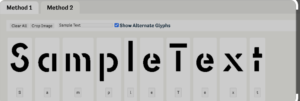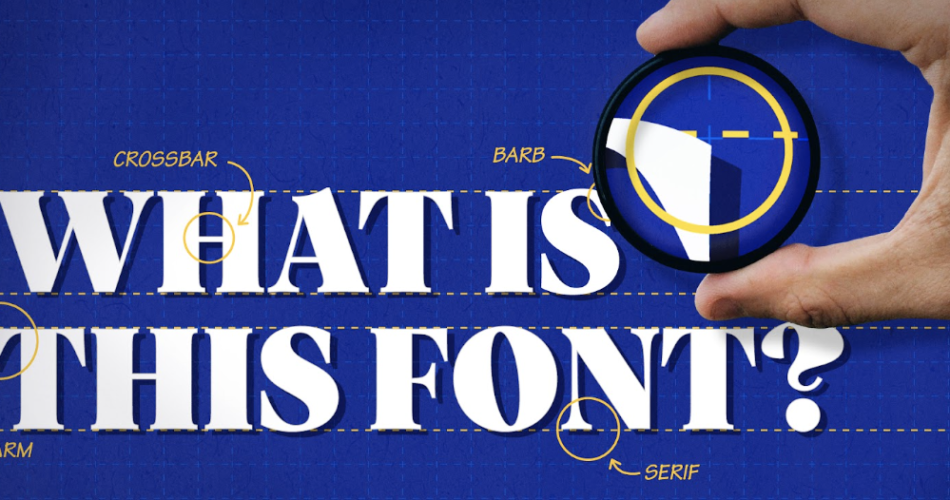The visual appeal of any design is greatly influenced by the choice of typography. In today’s digital age, where images play a crucial role in communication, selecting the right font for your images can make a significant impact. An image font, also known as a display font, adds a unique and captivating touch to your visuals, helping to convey your message effectively. In this comprehensive guide, we will dive into the world of image font finder, exploring their importance, understanding different types, discovering the psychology behind choosing the right one, and uncovering the tools and resources available to find the perfect image font for your design needs.

image font finder
The importance of typography in images
Typography is not just limited to text-based content; it plays an equally important role in images. When words are combined with visuals, they create a powerful synergy that captures the viewer’s attention and conveys the intended message. The font used in an image can evoke specific emotions, set the tone, and establish the overall aesthetic. Whether it is a social media post, a website banner, or an advertising campaign, the right typography can elevate the visual impact and enhance the user experience. It is crucial to understand the significance of typography in images and invest time and effort into selecting the perfect image font.
Understanding different types of image fonts
Image fonts come in various styles and forms, each with its unique characteristics. It is essential to have a basic understanding of these types to make an informed choice for your design. Serif fonts, with their elegant and classic look, are a popular choice for formal and traditional designs. Sans-serif fonts, on the other hand, are more modern and clean, making them suitable for contemporary and minimalistic designs. Script fonts mimic handwriting and add a personal and artistic touch to images. Display fonts are the most expressive and eye-catching, often used for headlines and titles. By familiarizing yourself with these different types of image fonts, you can narrow down your options and find the perfect fit for your design project.
The psychology behind choosing the right image font
Typography is not just about aesthetics; it also has a psychological impact on the viewer. Different fonts evoke different emotions and associations, which can influence how the message is perceived. For example, bold and thick fonts convey strength and authority, making them ideal for impactful statements. On the other hand, delicate and cursive fonts evoke elegance and femininity, suitable for romantic or sophisticated designs. Understanding the psychology behind choosing the right image font allows you to align the typography with the intended message and create a stronger emotional connection with your audience.
How to find the perfect image font
Finding the perfect image font can seem like a daunting task, given the vast array of options available. However, with a systematic approach, you can simplify the process and find the ideal font for your design. Start by defining the purpose and tone of your project. Are you aiming for a playful and fun vibe or a more professional and serious look? Once you have clarity on the desired style, explore font libraries and websites that offer a wide range of image fonts. Consider the readability, legibility, and scalability of the font before making a final selection. It is also essential to consider the compatibility of the font with different devices and platforms to ensure a consistent experience across various mediums.
Image font finder tools and resources
In the digital age, there are numerous tools and resources available to help you find the perfect image font. Online font finders allow you to search for fonts based on specific criteria, such as style, mood, or theme. Some popular font finder tools include Adobe Fonts, Google Fonts, and Font Squirrel. These platforms provide a vast collection of image fonts, along with advanced search filters to narrow down your options. Additionally, graphic design communities and forums are great resources to explore, as they often share recommendations and reviews of different image fonts. By leveraging these tools and resources, you can streamline your font selection process and save valuable time and effort.
Tips for using image fonts effectively
While selecting the right image font is important, using it effectively is equally crucial to create impactful designs. Here are some tips to help you make the most out of your chosen image font:
- Consider readability: Ensure that the font is legible, even at smaller sizes, to avoid any confusion or frustration for the viewer.
- Maintain consistency: Stick to a limited number of fonts throughout your design to maintain a cohesive and professional look.
- Pair fonts thoughtfully: If you need to use multiple fonts, choose complementary ones that harmonize well together.
- Use appropriate font weights: Experiment with different font weights to add emphasis and create visual hierarchy within your design.
- Balance font size: Pay attention to the proportion of font sizes in your design, ensuring that important elements stand out without overwhelming the composition.
By following these tips, you can maximize the impact of your image font and create visually stunning designs.
Best practices for incorporating image fonts in design
Incorporating image fonts in your design requires careful consideration of various factors. Here are some best practices to keep in mind:
- Understand the context: Analyze the purpose and context of your design to choose an image font that aligns with the overall message.
- Experiment with contrast: Play with the contrast between your image font and the background to create visual interest and enhance readability.
- Pay attention to spacing: Proper letter and line spacing can greatly improve the legibility and overall aesthetic of your design.
- Optimize for different devices: Test your design on different devices and screen sizes to ensure that the image font is displayed correctly and maintains its impact.
By following these best practices, you can seamlessly integrate image fonts into your design and create visually stunning results.
Case studies: Successful use of image fonts in branding
To truly appreciate the power of image fonts, let’s explore some real-world examples of successful branding campaigns that have effectively utilized typography in their design:
1. Coca-Cola: The Coca-Cola logo, with its distinctive cursive font, has become an iconic symbol of the brand’s timeless appeal and authenticity.
2. Airbnb: Airbnb’s use of the playful and friendly font in their logo and marketing materials reflects the brand’s focus on creating unique and memorable experiences.
3. Nike: Nike’s bold and dynamic font choice represents the brand’s commitment to strength, determination, and athletic excellence.
These case studies highlight the impact that image fonts can have on branding, reinforcing the importance of selecting the right typography for your design.
Conclusion: Unlocking the power of typography in images
In conclusion, typography plays a vital role in the visual appeal and effectiveness of images. By understanding the different types of image fonts, considering the psychology behind font selection, and utilizing the available tools and resources, you can find the perfect image font for your design needs. Remember to use image fonts effectively by following the tips and best practices outlined in this guide. By unlocking the power of typography in images, you can enhance the impact of your designs and create a lasting impression on your audience. So, go ahead and explore the world of image fonts, and let your creativity soar!

